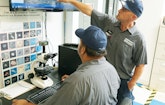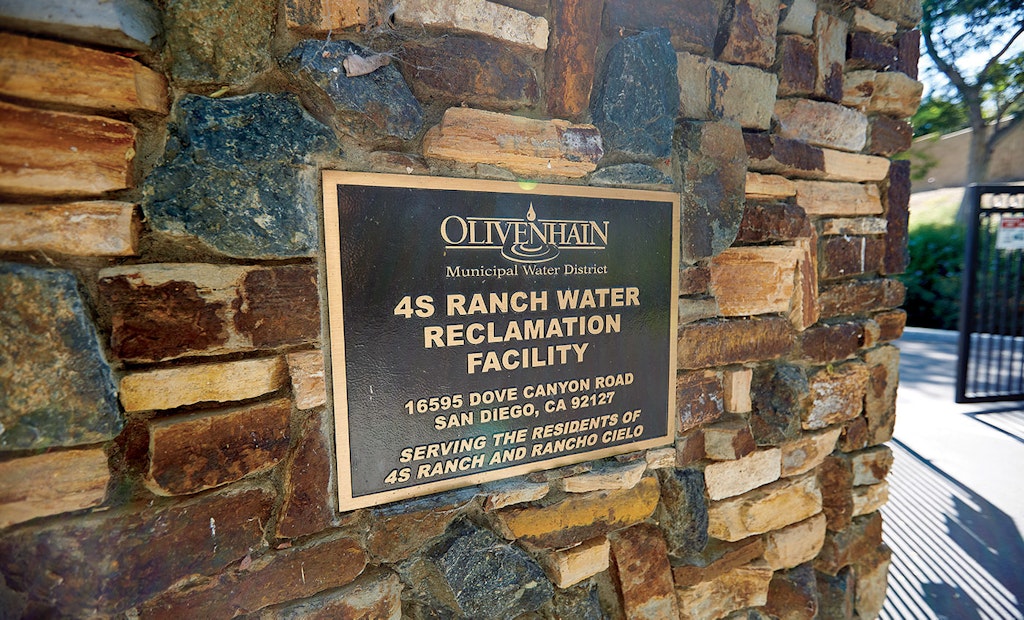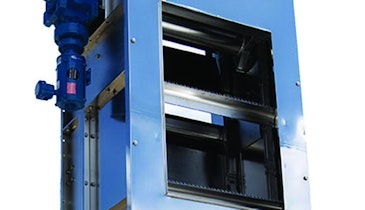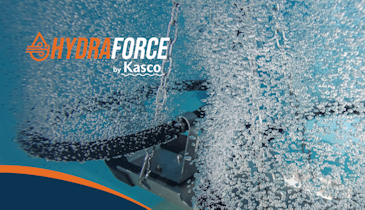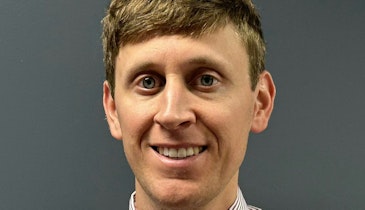Interested in Treatment?
Get Treatment articles, news and videos right in your inbox! Sign up now.
Treatment + Get AlertsIn a part of the country where freshwater supplies are often scarce, the Olivenhain (California) Municipal Water District is doing its part.
The 4S Ranch Water Reclamation Facility recycles some 1 million gallons of high-quality effluent each day for irrigation and shares even more with neighboring communities. “We’re reusing 100%,” says John Onkka, facilities supervisor. “We have no outfall.”
What doesn’t go directly to irrigation is stored in reservoirs to meet spring and summer demands. The district partners with other utilities to meet all of its customers’ irrigation needs.
A consistent safety award winner, the facility also won the California Water Environment Association Plant of the Year award in 2018. Communications in both directions, to the public and among the staff, are strong reasons for the success.
Tertiary process
Onkka’s team is responsible for collections and treatment. The system feeding the plant contains 15 pump stations, 65 miles of gravity sewer and 25 miles of force main.
At the plant, wastewater passes through a headworks containing a Bandscreen Monster grinder (JWC Environmental) and a grit removal system. The flow then passes through a splitter box to an oxidation ditch set up for extended aeration. Two Flender Gear units provide aeration for the ditch.
The plant has two treatment trains. The older Train A is held in reserve and used for storage or when the other train is being worked on. The newer Train B serves as the main treatment system. After treatment in the ditch, the flow moves on to a pair of circular clarifiers, operated using Eimco drives (Ovivo USA).
Two 225,000-gallon equalization tanks provide storage and flow control. A US Filter shallow-bed sand filter system (Evoqua Water Technologies) polishes the water and removes fine particles; it is backwashed twice a day on average. Filtrate is UV disinfected and sent to a recycled water pump station. In summer, the water is pumped into the Olivenhain’s distribution system. In winter, it is stored in a pond that can hold 410 acre-feet of water and is available to users as needed.
Water that is directly recycled is pumped through 46 miles of purple pipelines to customers throughout the southeast quadrant of the district. Users include homeowner associations, schools, parks, golf courses and street departments. None of the recycled water is used for residential lawns or green spaces.
Biosolids are aerobically digested and aerated with a disc filter system (Sanitaire, a Xylem brand). The solids are then thickened and dewatered on a pair of recently rehabilitated belt filter presses (Alfa Laval). The cake is applied to alfalfa and barley fields around Yuma, Arizona.
Making it better
While the plant operates in an award-winning fashion, improvements are in the future. “We’re planning to change our UV units to a WEDECO - a Xylem Brand Duron system, which uses fewer lamps to accomplish the same amount of disinfection,” Onkka says.
Plant instrumentation is being upgraded through the addition of a Hach RTC system, which will add more ammonia and nitrate probes and analyzers in the aeration section of the oxidation ditches. That will establish better setpoints and produce better data, enabling the plant to adjust more effectively between night and day operation.
New instrumentation and valving are being added to the sand filter system, which Onkka says should last another 10 years. The plant just added a new skid-mounted polymer dosing system (UGSI Chemical Feed, a UGSI Solutions Co.) and installed new chlorine pumps (Blue-White Industries) to control algae growth in the equalization system and support the chlorine residual in the distribution holding tank. Because households lie on and above the plant’s property boundaries, two chemical scrubbers (Integrity Municipal Systems) control odors.
Weather is a factor in the recycled water scheme. Recent winters have been rainy, reducing usage of the recycled water storage basin contents. “This past winter, we had pretty unusual patterns and amounts of rain,” Onkka says. “No one was using the recycled water, and the pond was filling up.”
The staff was in touch with regulators to discuss the possibility of the pond overflowing into the storm drain, or amending the district’s permit to allow recycled water to flow into a nearby creek. “Finally, the rain stopped and we breathed a sigh of relief,” Onkka says.
Kim Thorner, district manager, adds, “We were pretty nervous. We have one large reservoir and two smaller ones, but otherwise there’s no place to put it.”
Finding customers
One solution is to find more customers, and new soccer fields in the San Diego area are coming on board as recycled water customers. Negotiations with other districts and communities is an important part of the district’s success. “We partner with the Rancho Santa Fe Community Services District or the City of San Diego to provide supplemental water as needed,” Thorner says.
In the northwestern quadrant of the district, the district purchases recycled water from neighboring districts. It’s a coalition approach that enables the district to collaborate with other agencies. As a result, Thorner says, the district has met its objective to reduce potable water for nonresidential irrigation by 15%.
Not all the challenges facing the district relate to distribution. “Wipes and other disposables are a major issue,” Onkka says. “At the plant, the headworks screens are effective in removing these objects, but they can be a problem in the collections system.”
Decreased flows throughout the system, brought about by water conservation in drought conditions, can cause additional problems. The system sees an increase in hydrogen sulfide odors, as well as corrosion, and the treatment plant can experience increased ammonia. “That’s the long-term trend,” Onkka says. “We’re seeing per capita water usage in our households going down.” Per- and polyfluoroalkyl substances (PFAS) are looming as an issue as regulators pay more attention to those contaminants.
Community collaboration
Onkka and the district view water reuse as a partnership between the water system and the end users. It’s a relationship that depends on active and effective public communication. That effort needs to be continuous. “In the end, it’s always a challenge to educate our customers about recycled water, how it’s safe and what we do,” Onkka says.
The 4S Ranch facility and the district publish a bimonthly newsletter and use social media, including tweet of the week. Team members take pictures of what they’re working on and send them to the public relations department for use on social media.
“It’s cool,” Onkka says. “If you’re replacing a motor, take a picture and send it in.” An incentive program encourages team members to do just that. An annual open house at the plant is a hit: “We’ve done it six years in a row now. We open the gate and set up booths that describe all activities at the plant. We invite vendors. We feature a landscape education program — how to use sprinklers and save water by drought-proofing your grass. We encourage people to convert to native landscapes.”
Board members are on hand to talk with visitors, and the staff leads tours of the plant. “It’s family friendly,” Onkka says. “We hand out snow cones and popcorn. Overall, it’s a big success.” When areas are added to the recycle system, team members go out to meet with and educate the new customers.
Staff pride
Internal communication is just as important to the success of the recycled water program. Onkka supervises five operators and one cross-connection control specialist. Two of the district’s electricians and two pump and motor technicians report to the plant. In 2016, one of them, Dominic “Bruno” Brunozzi, was named California Water Environment Association Mechanical Technician of the Year.
“It’s a great team,” Onkka says. “We work well together, and we take pride in our work. Our team does a tremendous job keeping the plant and collections system in compliance.” He points to the recent awards as evidence of teamwork.
Experience is another plus. “Three of our guys have 10-plus years of experience. They like it here and are motivated to be successful. I respect them as professionals. We set a professional tone. We don’t look down on or demean anyone. It’s a team environment and an open door. There are no fears of making a mistake.”
Onkka says acceptance of responsibility and willingness to learn are important factors in his staff’s success. It’s a theme echoed by Thorner: “They have a great group of people. We’re proud of the plant and the awards they’ve won.”
A culture of safety
A safety program that John Onkka calls “extremely robust” has kept operations at the 4S Ranch Water Reclamation Facility safe for years and has led to the clean-water profession’s top safety award.
“Safety is a huge part of our culture,” says Onkka, facilities supervisor. The program includes semimonthly safety committee meetings, a monthly team member forum that includes safety topics, a safety incentive program and safety suggestion box.
For these efforts, plus a spotless performance record, the facility has won the California Water Environment Association Safety Plant of the Year award and recently the Water Environment Federation’s George W. Burke Jr. for safe operations.
“That was a big deal for us,” Onkka says. “We’ve gone an unheard of number of days — over 4,900 — without a lost-time accident. We’re all very proud of our safety record.” The safety committee includes two board members, plus key senior staff, and the water plant and operations supervisors. A safety subcommittee meets monthly and brings concerns and ideas forward to the larger committee.
At the team-member forum, safety issues are discussed. Each month, team members receive safety handouts that include such topics as active shooter situations and cybersecurity.
The incentive program includes safety awards for meeting certain targets. For example, every team member is eligible for up to a $150 recognition award if there are no lost-time injuries during the calendar year and damage to vehicles or property is less than $10,000.



